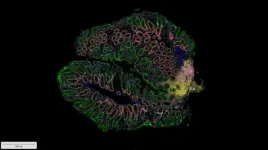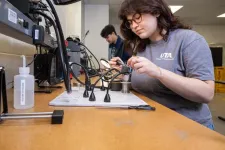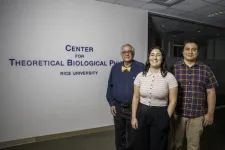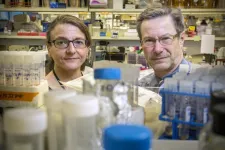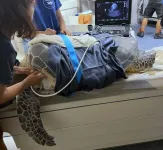(Press-News.org) By Jake Siegel
Seattle, WA—May 13, 2024—With pediatric inflammatory bowel disease (IBD) diagnoses on the rise globally, a clinical trial in Seattle aims to transform treatment approaches through deep molecular profiling.
Recruitment has begun for the Seattle STRIDE study, a joint effort by Seattle Children’s Research Institute and the Allen Institute for Immunology. The trial aims to enroll 200 volunteers and follow them over three years. It will employ a range of genomic tools to analyze intact tissue samples from routine tests. These single-cell analysis methods will provide a detailed look at how the immune system behaves in patients with IBD and how it responds over time to specific drug treatments.
Deep immune profiling could offer an unprecedented view of the disease, paving the way for new and improved treatments, said Betty Zheng, MD, an assistant professor of pediatrics at Seattle Children’s and the study’s principal investigator.
“IBD is a very complex disease, and we only have a rough understanding of what is happening at a molecular level,” she said. “By partnering with the Allen Institute, we want to get a detailed view of the disease’s molecular mechanisms to find better ways of treating the patients we see in the clinic.”
Unraveling molecular mysteries
The exact causes and progression of IBD, a chronic inflammatory condition affecting the digestive tract, have remained elusive, Zheng said. It likely involves some combination of genes, immune dysregulation, and environmental and dietary factors.
In children, IBD is both more aggressive and harder to treat. Around 30% of pediatric IBD patients do not respond to initial treatments. Furthermore, nearly half of the remaining patients will find their treatments becoming ineffective over time. These children face risks like impaired growth, mental health issues, and missed educational and social activities.
A deeper molecular understanding of the disease could enable personalized treatment strategies, moving away from less effective one-size-fits-all approaches, Zheng said.
“Some children find relief with first-line therapies, others require a combination of treatments, and some don’t respond to anything and languish in the hospital for months,” Zheng said. “This is a big question mark in the clinic.”
A deep dive into the molecular workings of the disease could also uncover unknown pathways of inflammation. These pathways could potentially serve as targets for the development of new drugs. “There is a universe of information that is not being seen,” said Adam Savage, Ph.D., an Assistant Investigator at the Allen Institute for Immunology.
To explore that universe, Savage and other scientists will deploy a suite of advanced technologies refined at the Allen Institute for Immunology that can identify and pinpoint immune cells and molecules inside tissues collected during routine hospital visits. By analyzing patient samples over time, these tools can offer a window into how the disease progresses and how patients respond to treatment.
Behind the data and the advanced technologies, the ultimate goal remains clear: improving the lives of patients.
“We look at data on computers, or head into the labs, and we can get a little detached,” Savage said. “But when we visit and see the patients we’re trying to help, it’s a powerful reminder of why we come to work—to have a real impact on patients’ lives.”
Families interested in joining the Seattle STRIDE study can learn more here.
About the Allen Institute
The Allen Institute is an independent, 501(c)(3) nonprofit research organization founded by philanthropist and visionary, the late Paul G. Allen. The Allen Institute is dedicated to answering some of the biggest questions in bioscience and accelerating research worldwide. The Institute is a recognized leader in large-scale research with a commitment to an open science model. Its research institutes and programs include the Allen Institute for Brain Science, launched in 2003; the Allen Institute for Cell Science, launched in 2014; the Allen Institute for Immunology, launched in 2018; and the Allen Institute for Neural Dynamics, launched in 2021. In 2016, the Allen Institute expanded its reach with the launch of The Paul G. Allen Frontiers Group, which identifies pioneers with new ideas to expand the boundaries of knowledge and make the world better. For more information, visit alleninstitute.org
###
Media Contact
Peter Kim, Sr. Manager, Media Relations
peter.kim@alleninstitute.org
END
Impact Journals is proud to participate at the Society for Scholarly Publishing (SSP) 46th Annual Meeting.
BUFFALO, NY- May 13, 2024 – Impact Journals is proud to participate as an exhibitor at the Society for Scholarly Publishing (SSP) 46th Annual Meeting, which convenes in Boston, Massachusetts, at the Westin Boston Seaport District from May 29–31, 2024. This year, the SSP Annual Meeting theme is “Inflection Point: Setting the Course for the Future of Scholarly Communication.”
Visit booth #212 at the SSP 46th Annual Meeting 2024 to connect with members of the Impact Journals team.
About ...
UTA has recently received the Innovation and Economic Prosperity (IEP) designation from APLU, the Association of Public and Land Grant Universities.UTA has recently received the Innovation and Economic Prosperity (IEP) designation from APLU, the Association of Public and Land Grant Universities.UTA has recently received the Innovation and Economic Prosperity (IEP) designation from APLU, the Association of Public and Land Grant Universities.UTA has recently received the Innovation and Economic Prosperity (IEP) designation from APLU, the Association of Public and Land Grant ...
Texas Tech University’s Biological Threat Research Laboratory (BTRL) played a key role in detecting the first case of highly pathogenic avian influenza (HPAI) A (H5N1) transmitted from a mammal (dairy cow) to a human.
The case was made public in an article published in the New England Journal of Medicine. Steve Presley, the director of The Institute of Environmental and Human Health (TIEHH) and the BTRL, and Cynthia Reinoso Webb, the biological threat coordinator at TIEHH, were co-authors on the journal publication.
The journal article explains that in March a farm worker who reported no contact with ...
Today, there are dozens of large language model (LLM) chatbots aimed at mental health care — addressing everything from loneliness among seniors to anxiety and depression in teens.
But the efficacy of these apps is unclear. Even more unclear is how well these apps work in supporting specific, marginalized groups like LGBTQ+ communities.
A team of researchers from the Harvard John A. Paulson School of Engineering and Applied Sciences, Emory University, Vanderbilt University and the University of California Irvine, found that while large language models can offer fast, on-demand support, they frequently fail to grasp the specific challenges that many members ...
A deadly strain of cholera bacteria that emerged in Indonesia back in 1961 continues to spread widely to this day, claiming thousands of lives around the world every year, sickening millions — and, with its persistence, baffling scientists. Finally, in a study published today in Nature, researchers from The University of Texas at Austin have discovered how this dangerous strain has held out over decades.
A longstanding mystery about the strain of Vibrio cholerae (V. cholerae) responsible for the seventh global cholera pandemic is how this lineage has managed ...
Rice University’s Peter Wolynes and his research team have unveiled a breakthrough in understanding how specific genetic sequences, known as pseudogenes, evolve. Their paper was published May 13 by the Proceedings of the National Academy of Sciences of the United States of America Journal.
Led by Wolynes, the D.R. Bullard-Welch Foundation Professor of Science, professor of chemistry, biosciences and physics and astronomy and co-director of the Center for Theoretical Biological Physics (CTBP), the team focused on deciphering the complex energy landscapes of de-evolved, putative protein sequences corresponding to pseudogenes.
Pseudogenes are ...
Embargoed for release until 5:00 p.m. ET on Monday 13 May 2024
Annals of Internal Medicine Tip Sheet
@Annalsofim
Below please find summaries of new articles that will be published in the next issue of Annals of Internal Medicine. The summaries are not intended to substitute for the full articles as a source of information. This information is under strict embargo and by taking it into possession, media representatives are committing to the terms of the embargo not ...
Chatbots share limited information, reinforce ideologies, and, as a result, can lead to more polarized thinking when it comes to controversial issues, according to new Johns Hopkins University–led research.
The study challenges perceptions that chatbots are impartial and provides insight into how using conversational search systems could widen the public divide on hot-button issues and leave people vulnerable to manipulation.
“Because people are reading a summary paragraph generated by AI, they think they’re getting unbiased, fact-based answers,” said lead author Ziang Xiao, an assistant professor of computer ...
SEATTLE — May 13, 2024 — Researchers at Fred Hutch Cancer Center have found in pre-clinical studies that an experimental gene therapy for genital and oral herpes removed 90% or more of the infection and suppressed how much virus can be released from an infected individual, which suggests that the therapy would also reduce the spread of the virus.
“Herpes is very sneaky. It hides out among nerve cells and then reawakens and causes painful skin blisters,” said Keith Jerome, MD, PhD, professor ...
OTTAWA, Ontario, May 13, 2024 – Six out of seven sea turtle species are endangered, and humans are primarily responsible. Commercial fishing activities are the largest human-caused disturbance to sea turtles due to accidental capture.
Fishers are typically unaware if a sea turtle is caught in their net until it’s completely pulled out of the water. However, releasing sea turtles without veterinary evaluations can be harmful. When accidentally caught, the turtles’ normal diving processes are interrupted, ...
